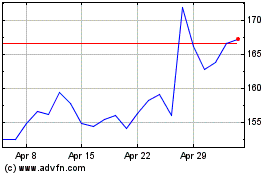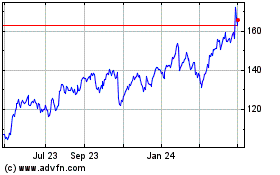By Roque Ruiz, Katherine Riley and Sarah E. Needleman
If there is one thing Epic Games Inc. and Apple Inc. can both
agree on even as they battle each other, it is that the app economy
is worth fighting over.
In the 13 years since Apple launched its App Store, the number
of apps has exploded. The business of delivering them to people's
smartphones has grown into a revenue stream worth tens of billions
of dollars annually for Apple and the other main marketplace
operator, Alphabet Inc.'s Google.
App stores have become critical gatekeepers in accessing
software that lets users do everything on the internet, including
watch television, read books and check the weather. Key to the
stores' business models is that they collect a commission on
consumers' purchases of digital goods and services. They don't take
a portion of sales of real-world goods and services, like T-shirts
or car rides purchased through an app from their stores, but when
someone spends on a videogame perk or subscribes to an online
fitness program, the gatekeepers get their cuts.
The fees that Apple and Google charge -- 30% in many cases --
are at the center of lawsuits filed by "Fortnite" creator Epic
Games against the tech giants. Epic claims that Apple's App Store
rules stifle competition and run afoul of antitrust law. Apple
disputes Epic's allegations, saying that its rules are applied
evenly and that charging a commission is legal and covers expenses
such as maintaining user privacy.
The trial in Epic's case against Apple started May 3 and has the
potential to upend a key part of the iPhone maker's services
business.
Here is a snapshot of the rising app economy.
Consumers spend billions of dollars in app stores.
Consumer spending on digital goods and services has surged over
the years, according to analytics firm Sensor Tower, and the amount
of money the companies make off commissions has grown in
tandem.
Apple launched the App Store in 2008 -- the year after it
introduced the first iPhone -- with 500 apps. The Google Play store
was launched in 2012 by integrating the Android app marketplace
with Google's music and ebook platform. Each company's decision to
require in-app purchases of digital goods, services and
subscriptions to be routed through their payment-processing systems
helped bolster revenue for both.
Apple and Google both recently pledged to reduce their
commissions for developers in some instances starting this
year.
Game apps dominate spending.
Mobile games generate revenue mainly through sales of virtual
goods or access to special modes of play. That spending has
propelled game apps such as Tencent Holdings Ltd.'s "Honor of
Kings" and Niantic Inc.'s "Pokémon Go" to among the biggest apps by
annual revenue in the App Store and Google Play, according to
Sensor Tower.
Digital ads are growing in apps.
In addition to in-app purchases, many apps make money through
advertising sales, a business that has been growing in recent
years, data from Omdia show. Ads commonly appear in games as videos
that reward players for watching them with in-game perks. Apple and
Google set the guidelines that enable developers to generate
revenue from in-app ads.
Apple doesn't make money directly from in-app ads, but Google
does with its AdMob platform. Both companies offer developers the
option to pay to have their apps featured at the top of users'
search results or to reach customers on app-store pages. Such
revenue isn't captured, however, in the chart below.
Netflix, Tinder and TikTok are among the most popular nongame
apps.
More nongame apps have been among the top 10 apps for consumers'
digital spending in the App Store than in Google Play in recent
years. Those apps have included Netflix Inc., Match Group Inc.'s
Tinder and ByteDance Ltd.'s TikTok.
Epic, whose "Fortnite" game has been among the top mobile apps
by digital spending, has tried to broaden its attack on Apple and
Google beyond the game world. It has sought testimony from the
companies including Match and Spotify Technology SA, as well as
smaller app developers, to help make its case. A Match executive
told a Senate panel last month that app-store fees are the
company's fastest-growing expense and would soon eclipse $500
million annually.
Netflix, Spotify and other companies have sidestepped Apple's
cut by shifting to selling subscriptions and downloads through
their websites instead of their apps. Apple bars companies from
mentioning in their apps where else consumers can go to subscribe,
and it doesn't let companies mention the 30% cut of revenue it
collects.
Consumers are downloading more apps than ever.
The growth in downloads reflects how people are increasingly
turning to mobile devices as their primary means of accessing the
internet. It also speaks to the popularity of the free-to-play and
"freemium" models embraced by developers, which give consumers a
chance to try an app before having to commit to spending any money
on it.
Free-to-play games are entirely free but offer the option to
purchase virtual perks or experiences, while freemium apps provide
basic features at no cost and charge for additional or full
access.
The number of app-store developers is rising.
The pool of active developers on Apple's App Store and Google's
Play store has steadily grown over the years, a trend driven by
people's increased reliance on mobile devices for accessing the
internet, according to analysts at analytics firm App Annie Inc.
The pandemic accelerated that trend, boosting demand in particular
for food-and-drink, shopping and game apps, they said.
Most apps in Apple's App Store are free.
The total number of apps in the App Store was lower last year
than in 2017, in part because Apple purges those that no longer
meet its criteria for inclusion. It completed big purges of apps
from its platform in 2016 and 2017.
Meanwhile, the proportion of apps that are free and don't offer
in-app purchases has increased. Despite this trend, Apple's App
Store revenue has been rising because consumers have been spending
more money in apps that do offer in-app purchases as well as on
paid apps. The number of active iPhones world-wide also has
increased to more than a billion this year from around 900 million
in 2019.
Write to Roque Ruiz at Roque.RuizGonzalez@wsj.com and Sarah E.
Needleman at sarah.needleman@wsj.com
(END) Dow Jones Newswires
May 16, 2021 05:44 ET (09:44 GMT)
Copyright (c) 2021 Dow Jones & Company, Inc.
Alphabet (NASDAQ:GOOGL)
Historical Stock Chart
From Mar 2024 to Apr 2024

Alphabet (NASDAQ:GOOGL)
Historical Stock Chart
From Apr 2023 to Apr 2024
